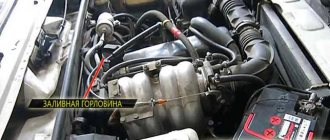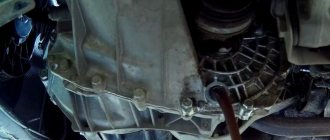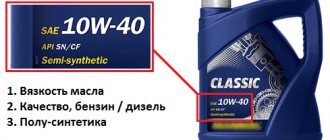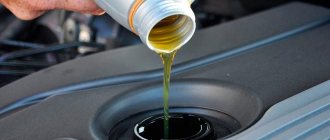To select a car oil, no professional experience is required - minimal theoretical knowledge, which is in the operating instructions, is sufficient. In order not to make a mistake in your choice, it is enough to know the parameters of viscosity, tolerance, degree of quality, types of motor oils, as well as their best manufacturers. You also need to be aware of the volume of oil being poured, otherwise underfilling or overfilling can lead to problems with engine operation. In this article, using the example of the popular Lada Vesta car, we will consider in detail how to choose the right engine oil.
Replacement frequency
The AvtoVAZ company recommends pouring oil into the Vesta engine every 10 thousand kilometers. According to auto experts, this is quite an optimal indicator, taking into account the harsh climatic conditions in Russia. In the European region, the requirements are completely different, and may differ for the better. Under the influence of negative climatic factors, the liquid quickly becomes unusable, as a result of which the oil loses its beneficial properties and is no longer able to cool engine components, and thereby prevent them from overheating. If the car is subjected to extreme loads - for example, driving on light off-road conditions, including dusty roads, or carrying a heavy load and moving at high speed, this also negatively affects the life of the oil, and at the same time affects the reliability of the power plant. In such cases, it would be advisable to reduce the oil change schedule even further - up to 7-5 thousand kilometers. At the very least, this will protect the engine from premature wear of components, due to the rapid loss of the oil’s beneficial properties.
The most popular articles on the site:
- How often should you change engine oil?
- Oil 5w30 and 5w40 what is the difference
- What oil to pour into the engine in winter and summer
- How long does it take to change the automatic transmission oil?
Beware of fakes!
The automotive chemicals market offers a lot of high-quality products, but, unfortunately, counterfeit products are often found.
Although you can find various tips on the Internet on how to recognize a fake, sometimes it can only be determined in the laboratory.
It is impossible to guarantee complete protection against counterfeit oils, but the risk will be significantly reduced if you adhere to the following rules:
- always purchase auto chemicals from specialized retail outlets;
- do not buy goods at a suspiciously low price;
- check the packaging for holograms,
- pay attention to the quality of the label;
- ask the seller for a certificate.
Fake motor oil is often impossible to identify by appearance, but it can increase oil consumption, make it more difficult to start an internal combustion engine, especially in cold weather, and the lubricant itself will quickly lose transparency.
If there is any suspicion of counterfeit oil, you should immediately drain the oil and replace it immediately, since it is much more important to maintain engine performance than to save on engine oil.
Model: Lada Vesta
How to understand that the oil has become unusable
There are several reasons why your oil may be in poor condition. So, first you should check the amount of oil. This can be done using the dipstick, which is located in the oil filler hole. The dipstick must be pulled out of the hole and look at the oil imprint. If its color is dark brown (initially it was transparent), then this clearly indicates traces of mechanical wear. In addition, there are other factors - for example, smell - if the liquid smells burnt, this also indicates problems caused by pouring low-quality oil and the consequences of unfavorable weather and road conditions. The situation is further aggravated by the fact that the oil may contain sediment in the form of metal particles. In this case, the oil will have to be replaced urgently, otherwise you may face irreversible consequences fraught with major engine overhauls.
Features of the HR16DE/H4M engine
The cylinder block has two camshafts and four valves per cylinder. The camshafts are driven by a silent chain with an automatic tensioner, which is designed for the entire service life of the engine.
Thermal clearances in the valve drive are regulated by selecting pushers (there are no hydraulic compensators). The oil pump is located at the top of the engine sump and is driven by a chain. The main and additional catalytic converters are located in the exhaust pipe.
The HR16DE/H4M engine is equipped with an automatic variable valve timing system, which improves the filling of the engine cylinders in all operating modes. To do this, phase regulators rotate the sprockets of the intake camshafts relative to the shafts themselves. The phase regulators are controlled by a hydraulic drive, which uses the oil pressure of the engine lubrication system. The flow of oil is controlled by a phase change solenoid valve, which in turn controls the ECU (electronic engine control unit).
When is an oil check needed?
Typically, car enthusiasts prefer to wait for the replacement schedule, and only then check the oil - when it’s too late. It is advisable to check the condition of consumables in advance, because this will avoid problems with the motor. So, you need to check the oil if you notice the following signs:
- Insufficient engine power
- The motor is not able to develop high speeds
- High fuel consumption
- Excessive oil consumption
- Gearbox shifts with delay
- Noises and vibrations
Specifications HR16DE/H4M
Comparative table of engine characteristics: VAZ 21129, 21179 and HR16DE/H4M:
| Engine model | VAZ 21129 | HR16DE/H4M | VAZ 21179 |
| Symbol | 1.6 l, 16 cl | 1.8 l, 16 cl | |
| Type | Petrol, 4-cylinder, in-line | ||
| Working volume, l (cm 3) | 1,6 (1596) | 1,6 (1596) | 1,8 (1774) |
| Cylinder diameter, mm | 82 | 78 | 82 |
| Piston stroke, mm | 75,6 | 83,6 | 84 |
| Compression ratio | 10,5 | 10,7 | 10,3 |
| Number of camshafts | 2 | ||
| Number of valves per cylinder | 4 | ||
| Timing drive type | Toothed belt | Chain | Toothed belt |
| When the timing belt breaks | Valve bending (until 08/15/18) | — | Valve bend |
| Rated net power, kW/hp. (at crankshaft rotation speed, min -1) | 75/106 (5500) | 81/110 (5800) | 90/122 (6000) |
| Maximum net torque, Nm (at crankshaft speed, min -1) | 148/4200 | 150/4000 | 170/3750 |
| Minimum crankshaft rotation speed at idle, min -1 | 840 | 675-725 | 840 |
| Weight, kg | 92,5 | n.d. | 109,7 |
| Ignition system | Electronic, contactless, microprocessor controlled | ||
| Cylinder operating order | 1-3-4-2 | ||
| Supply system | Multiport fuel injection | ||
| Fuel | Unleaded gasoline with octane number 95* | ||
| Availability of neutralizer | Eat | ||
| Toxicity standards | Euro 5 | ||
| Oil consumption depending on fuel consumed, % | 0,3 | 0,3 | |
| Oil volume in the lubrication system of an engine with a cast (light-alloy) sump (manual transmission), l | 4,1 | 4,7 | 4,1 |
| Engine oil quality class according to API* | SL, SM or SN | ||
| Engine oil viscosity grade according to SAE* | see motor oil | see motor oil | see motor oil |
| Resource, km | 200 000 | ||
* — the recommended fuel is indicated; if it is not available, the manufacturer allows the use of gasoline with an octane number of at least 92.
Types of motor oils
Today there are three types of oils on the market, let’s look at them in more detail.
- Synthetic is the best motor oil today. It has high fluidity and resistance to low temperatures. It can be safely recommended for Lada Vesta, as well as for other modern cars, including premium ones. Lada Vesta is the most modern AvtoVAZ car, consuming only high-quality consumables.
- Mineral is the most affordable motor oil. It has an excessively thick consistency, which makes it impossible to use in frosty conditions. It is only suitable for warm climates. In addition, it will have to be changed much more often than synthetic oil.
- Semi-synthetic – a mixture of synthetic and mineral oils. The best option for Lada Vesta in terms of cost and combination of useful properties. Definitely better and more modern than mineral oil.
1.l, 106 hp, gasoline, front-wheel drive, manual transmission/robot, 2015 - present. vr.
Edge 5W30 oil from the Castrol brand is an all-season synthetic that provides the internal combustion engine with reliable protection even at extreme loads, stable starting at low temperatures (down to -30 C). With this MM, the engine runs smoothly, and some fuel savings are even noted.
Helix HX8 5W40 from the manufacturer Shell is a high-quality synthetic oil at an affordable price, retains its original properties for a long time, and does not thicken in the cold.
Car owners also note its low consumption, and among the shortcomings it is worth highlighting only the fairly common counterfeit, since this brand is widely popular.
Where is
The drain plug in the Lada Vesta 1.8 engine is located under the bottom, covered with protection - a mud flap. To carry out prevention you will need a minimum of tools and time.
Removing the mudguard: key (head) to “10”. Drain plug with manual transmission: hexagon at “8”, AMT – key at “17”.
Oil filter
The oil filter is located above the drive shaft and cannot be removed without first removing the crankshaft sensor.
Technical features of N4M
The H4M engine was designed by the automaker Nissan for the Tiida and Note . The new product was demonstrated in 2004 at an exhibition at the Paris Motor Show . The engine design complied with the technical canons of the early 2000s: a lightweight four-cylinder block made of aluminum with a timing chain drive , 16 valves in the cylinder head without hydraulic compensators .
Electronic valve , injection through two injectors in each cylinder. A clear advantage was compliance with stringent environmental requirements of Euro 5 .
In 2015, this engine was successfully adopted by the Volzhsky Automobile Plant under the name N4Mk.
What cars was H4M installed on?
The H4M engine was harmoniously and rationally introduced into the creation of a large number of Nissan and Renault and was successfully adapted to each model.
This engine is installed in Nissan Terrano D10 from 2016 to the present day.
Since 2012, Renault cars , such as Arkana 1 (from 2019 ), Fluence 1 (from 2012 to 2017 ), Megane 3 (from 2013 to 2016 ), Sandero 2 , Duster 1 , Kaptur 1 , Megane 4 , Logan 2 and Sandero 2 Stepway (since 2016 ), Logan 2 Stepway (since 2018 ).
Lada cars also received this engine: X-Ray hatchback (since 2016 ), Vesta sedan 2180 , Vesta SW 2181 , Vesta Cross 2180 , Vesta SW Cross 2181 and X-Ray Cross (since 2019 ).










